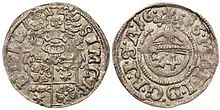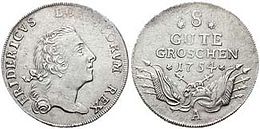Good penny
Guter Groschen (also Gutergroschen or Gutegroschen , abbreviation Ggr. ) Is the name of the royal groschen , which have been valued at 1 ⁄ 24 Reichstaler since the end of the 16th century , in contrast to the lighter Mariengroschen , which was only valued at 1 ⁄ 36 Reichstaler. The term "good penny" remained common until the middle of the 19th century.
Coin history
According to the district resolution of 1572, the princely groschen were provided with the imperial orb on the back , of which first 21, then 24 pieces resulted in a Reichstaler. These so-called apple groschen were mainly minted in northern Germany . In the time of money adulteration , the time of tipping and luffing , they deteriorated. After the kipper mints were closed , they were minted as “Gutegroschen”, increased in value. The penny name was initially intended to express the return to the imperial coin system and thus to good money. Subsequently, the grosch name also became common for the princely groschen of 1 ⁄ 24 Reichstaler, which had been struck since the end of the 16th century.
The mints were trying to meet the changing in value Mariengroschen by the Prince penny, so the good penny to 1 / 24 to replace Reichstaler, but they ran as 1 / 36 Reichstaler continue to.
In Salomon Haas' easily and clearly explained commodity calculation from 1769, the example of Saxony , Brandenburg and Braunschweig shows the subdivision of the coin types with good groschen:
- Division of the Brandenburg and Saxon Müntzen.
- 1 Rthl. has 24 good groschen.
- 1 good groschen has 12 pfennings .
- Division of the Braunschweigischen Müntzen.
- 1 Rthl. has 24 good groschen or 36 Marien groschen.
- 1 good groschen has 12 pfennings.
- 1 Marien-Groschen has 8 Pfenning.
- [...] The division of the Saxon Müntzen is the same as that of Brandenburg.
The division of Saxon and Brandenburg coins mentioned by Salomon Haas around 1769 was the same, but the Saxon thaler at 24 good groschen was a fictitious bill thaler , while the Prussian Reichstaler at 24 good groschen was minted according to the so-called Graumann coinage (14 pieces from the fine pulp , rough weight 22.272 g, 750 ‰ fineness , 16.704 g fine silver ).
The Kingdom of Hanover divided the dollars until the middle of the 19th century in 24 Gutegroschen each with 12 pennies.
8 good groschen from the Prussian King Friedrich II.
The 8-good-groschen piece of Frederick II of Prussia is an example of the issue of coins with the inscription "Good groschen".
The coin was minted in Berlin (A), Breslau (B), Kleve (C), Aurich (D), Königsberg (E), Magdeburg (F) and Stettin (G). In the Berlin mint with an interruption from 1753 to 1763. Three of the 8 good groschen pieces resulted in a Prussian Reichstaler at 24 good groschen (Gutegroschen) = 288 pfennigs . The designation of the low-value Prussian thaler, which was minted after the 14 thaler foot or 21 guilder foot, as the Reichstaler was perceived at the imperial court in Vienna as an affront of the Prussian king. The Reichstaler had so far been largely spared any deterioration in coins. However, the coin reform of 1750, which included the introduction of the 14 thaler foot, was the most important since the introduction of the thaler. After that, the Reichstaler no longer had to be differentiated into bill thaler and pronounced thaler.
Eight good groschen became the classic type of coin of the Seven Years' War (1756–1763). From 1756 to 1763 the coins were gradually issued with lower value. After the end of the war, the war coins were withdrawn in the years up to 1770.
The silver 8-groschen-piece, diameter 32 mm, weight 8.61 g, corresponded to the average weekly salary of a Prussian soldier.
Description of the coin
- Front:
- Head picture of Frederick II of Prussia, title inscription FRIDERICUS BORUSSORUM REX (Friedrich II. King in Prussia)
- Back:
- 8 / GUTE / GROSCHEN / 1754, flags and lances, including mintmark A of the Berlin mint
16 good groschen from the Kingdom of Hanover
Another example of the issue of coins with the inscription "Good Groschen" is the 16-good-groschen piece of the Kingdom of Hanover. The silver coin was from 1820 to 1834 under George III. (1760–1820), Georg IV. (1820–1830) and Wilhelm IV. (1830–1837) as kings of Great Britain and Hanover in many variations. The Kingdom of Hanover was ruled in personal union with Great Britain at that time . With these convention coins, too , the penny name goes back to the restoration of the princely penny after the Kipper and Wipper era (around 1623).
The legal basis was the convention footing (1817–1834) of 10 thalers (or 20 guilders ) from the fine mark . The 16 good groschen were worth half a conventional thaler . The thaler at 24 good groschen at 12 pfennigs each was a unit of account that was not represented by coins.
The nominal 16 good groschen (= ½ convention thaler), weight = 11.775 g, fine weight = 11.693 g, fineness = 993.56 ‰ has a diameter of 30 mm.
Description of the coin
- Front:
- Sachsenross jumping to the left, on the base is the medalist signature M of Heinrich Ludwig Maas, who worked in Hanover from 1815 to 1831 . Below: XX E (ine). Fine). MARK. Inscription: GEORGIUS IV. D (ei). G (ratia). BRITAN (niarium). ET. HANNOV (erae). REX.
- Back:
- Continuation of the title inscription BRUNSVICENSIS ET LUNEBURGENSIS DUX, in the field 16 / GUTE / GROSCHEN / 1825, underneath it arched FINE SILVER.
- (George IV by the grace of God, King of Britain and Hanover, Duke of Brunswick and Lüneburg.)
- The inscription FINE SILVER was intended to distinguish the coin from inferior similar coins.
Modern imprints are known of the 16 good groschen piece.
literature
- Paul Arnold, Harald Küthmann, Dirk Steinhilber: Large German coin catalog from 1800 to today . Augsburg 1997
- Lienhard Buck: The coins of the Electorate of Saxony 1763 to 1806. Berlin 1981
- Heinz Fengler, Gerd Gierow, Willy Unger: transpress Lexikon Numismatics , Berlin 1976, p. 135 Guter Groschen, p. 102 Fürstengroschen
- Bernd Kluge: That's enough for 8 groschen. Frederick the Great in his coins and medals , Museum Journal 1/2012
- Wolfgang Leschhorn : Brunswick coins and medals. 1000 years of coin art and monetary history in the city and country of Braunschweig , Appelhans-Verlag 2010, pp. 199–202, ISBN 978-3-941737-22-8 .
- Friedrich Freiherr von Schrötter (ed.), With N. Bauer, K. Regling, A. Suhle, R. Vasmer , J. Wilcke: Dictionary of Coin Studies , de Gruyter, Berlin 1970 (reprint of the original edition from 1930)
- Arthur Suhle: The coin. From the beginnings to modern European times , Leipzig 1969
Individual evidence
- ↑ Heinz Fengler,…: transpress Lexikon Numismatik …, p. 102, Fürstengroschen: First the shield groschen of Elector Friedrich II. Of Meißen (1428–1464) with his brother Wilhelm III. Margrave of Thuringia, who modeled the groschen of other German princes. From 1572 onwards, Fürstengroschen were the groschen with the imperial apple on the back (apple groschen).
- ↑ Friedrich von Schrötter…: Dictionary of Coin Studies …, p. 248
- ↑ Heinz Fengler, ...: transpress Lexikon Numismatics ..., p. 135
- ↑ Heinz Fengler, ...: transpress Lexikon Numismatics ..., p. 102
- ↑ Friedrich von Schrötter …: Dictionary of Münzkunde …, p. 32: Apple groschen were called the good groschen, which since around 1570 has been the imperial orb with the number 24, i.e. H. 24 = 1 Reichstaler, wore.
- ↑ Heinz Fengler, ...: transpress Lexikon Numismatics ..., p. 102
- ↑ Heinz Fengler, ...: transpress Lexikon Numismatics ..., p. 213
- ↑ Salomon Haas easily and clearly explained wares calculation, where all… , Frankfurt am Main, 1769, p. 7/10
- ^ Lienhard Buck: The coins of the Electorate of Saxony ... , p. 35
- ^ Paul Arnold, ...: Large German coin catalog from 1800 ... , p. 121
- ^ Gerhard Schön: German coin catalog 18th century , Munich: Battenberg, 1984, p. 531
- ↑ Bernd Kluge: It's enough for 8 groschen. Frederick the Great ... , p. 52
- ^ Lienhard Buck: The coins of the Electorate of Saxony ... , p. 36
- ↑ Arthur Suhle: The coin. From the beginning to ... , p. 179
- ↑ Arthur Suhle: The coin. From the beginning to ... , p. 180
- ↑ Bernd Kluge: It's enough for 8 groschen. Frederick the Great ... , p. 52/53
- ^ Paul Arnold, ...: Large German coin catalog from 1800 ... pp. 125–132
- ^ Paul Arnold, ...: Large German coin catalog from 1800 ... p. 121
- ^ Paul Arnold, ...: Large German coin catalog from 1800 ... p. 123
- ^ Paul Arnold, ...: Large German coin catalog from 1800 ... p. 122


